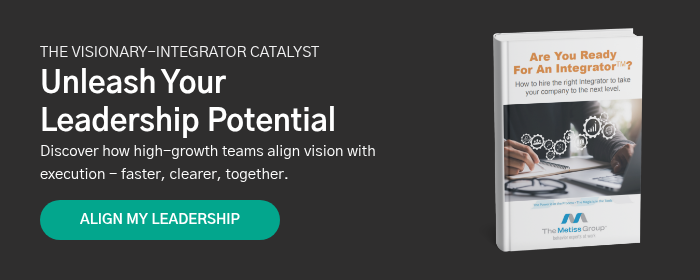Are You Ready to Hire an Integrator? A Strategic Guide for Visionaries
July 30th, 2025
5 min read
By John Gave

Entrepreneurial growth often hits a ceiling when the founder becomes the bottleneck. Strategy stalls behind execution gaps, initiatives pile up, and the leadership team begins operating on assumption rather than alignment. For Visionaries, this moment can feel both exhilarating and exhausting. They see the future with clarity but struggle to manage the present with consistency. What they need is not more time or ideas. They need an Integrator.
The concept of the Visionary-Integrator partnership was codified by Gino Wickman in his book Traction: Get a Grip on Your Business. In Traction, Wickman introduces the Entrepreneurial Operating System (EOS), a framework designed to help growth-oriented companies achieve clarity, discipline, and accountability. Rocket Fuel, the follow-up book co-authored by Wickman and Mark Winters, expands on the Visionary-Integrator dynamic. The authors argue when Visionaries pair with the right Integrator, the result is "rocket fuel" for the business. The Visionary drives big-picture thinking while the Integrator executes and leads operations, ensuring alignment and traction.
While the idea of hiring an Integrator is compelling, it is not universally appropriate. Premature hiring can backfire if the Visionary, leadership team, or organization is not prepared. This article outlines the key indicators of readiness using a structured lens: Visionary readiness, Leadership Team readiness, and Organizational readiness. These are not hypothetical checkpoints. They are essential criteria. A yes to each one is not optional. It is a prerequisite.
In this article, you will learn:
- Visionary Readiness: The Personal and Strategic Shift Required to Empower an Integrator
- Leadership Team Readiness: The Cultural and Operational Implications of a New Boss
- Organizational Readiness: The Financial and Functional Conditions Needed to Support Success
Visionary Readiness: The Personal and Strategic Shift Required to Empower an Integrator
Visionaries are often the founder, the cultural cornerstone, and the ultimate authority in entrepreneurial businesses. They generate momentum, shape values, and see market opportunities others overlook. But many Visionaries find it difficult to let go. That tension lies at the heart of whether hiring an Integrator will succeed or fail.
A few years ago, we worked with a Visionary named Paul. He’d built a thriving professional services company from the ground up and was doing over $15M in sales. But behind the scenes, things were breaking. His leadership team was confused about priorities, initiatives stalled, and Paul was working 65-hour weeks trying to hold it all together.
Everyone told him he needed an Integrator and he agreed. He hired someone sharp. Process-driven. Respected by the team. But six months in, that Integrator quit. Why?
Because Paul couldn’t let go. He still ran every leadership meeting, jumped into execution decisions, and fielded backchannel complaints.
Paul’s business didn’t have an Integrator problem. It had a Visionary readiness problem. Until he was willing to fully shift his role the system couldn’t work.
Think you’re ready to hand off the day-to-day? Here’s the test: Can you sit out of the weekly Level 10 meeting and trust someone else to run the show without texting the team afterward?. If not, you’re not ready. It’s not a knock. Letting go is one of the hardest moves a Visionary will ever make.. This means stepping back from operations and trusting another leader to manage execution. It also requires accepting the Integrator, not the Visionary, will run the weekly Level 10 (L10) meetings.
In fact, the Visionary can not even attend. This is not abdication. It is an elevation. Exhale! You won’t be left in the dark. In your Same Page Meetings with you Integrator, you’ll get all caught up at a strategic level; it’s not a good use of your time to get caught up in the minutia.
Scorecard accountability marks the next threshold. Both the Visionary and the Integrator must have measurable scorecards. These scorecards serve as the foundation for weekly check-ins and quarterly reviews. The Visionary must be willing to be held accountable to their own numbers. Equally, they must hold the Integrator accountable to theirs. This mutual accountability builds trust, clarifies expectations, eliminates redundancy, and prevents performance ambiguity.
Finally, perhaps the most subtle but crucial shift: the Visionary must commit to working through the Integrator, not around them. If the Visionary maintains a direct line to the leadership team, the Integrator’s authority is undermined. Organizational confusion follows. The entire EOS framework depends on this chain of command being honored in practice, not just on paper.
If the Visionary cannot yet say yes to these conditions, the business is not ready for an Integrator. It may be close, but close is not close enough.
Leadership Team Readiness: The Cultural and Operational Implications of a New Boss
Even if the Visionary is fully prepared, the Integrator will not succeed without active support of the leadership team. The team must be willing to shift its reporting line, embrace new accountability standards, and commit to a unified chain of command.
This begins with a cultural acceptance. The leadership team must be ready to report to someone other than the Visionary. For many, this is the first time they will have a boss who is not the founder or CEO. That can trigger uncertainty or resistance, especially if trust has not yet been built.
In contributing to the building of The Job Scorecards™ for both the Visionary and Integrator, generally, the leadership team begins to see what the Visionary really needs to be doing and how the Integrator will be more available and more focused on removing obstacles, not micromanaging their work.
Beyond reporting structure, the team must operationalize this new relationship by directing questions, updates, and decisions through the Integrator. This includes resisting the temptation to seek out the Visionary for clarification or approval. The new norm is alignment through the Integrator. Skipping this step erodes the structure and sends mixed messages.
The Visionary plays a crucial role here as well. Their willingness to defer questions back to the Integrator reinforces the structure. When team members bypass the Integrator and receive answers directly from the Visionary, the system begins to fracture. The Integrator cannot lead if their authority is routinely circumvented.
If even one leadership team member cannot accept this shift, hiring an Integrator will create more friction than focus. Readiness is not a majority vote. It is a unanimous commitment.
Organizational Readiness: The Financial and Functional Conditions Needed to Support Success
Beyond people dynamics, the organization itself must be structurally prepared to support an Integrator. This includes having the financial capacity, operational complexity, and strategic work volume to justify the role.
Financial readiness is the most straightforward. Hiring an Integrator is not a lightweight decision. This role comes with executive-level compensation. If the company cannot absorb this cost without compromising key investments, the hire should be deferred.
It’s critical for the Visionary to see this addition as an investment in future growth, not an expense to be absorbed.
Operational readiness is less visible but equally important. An Integrator thrives when there are cross-functional initiatives to drive, bottlenecks to remove, and systems to build. If the organization lacks meaningful projects or is still in an early-stage growth mode, the Integrator may find themselves underutilized. Idle executives erode culture and impact.
The final readiness factor is philosophical. The company must accept that the best-fit Integrator may not come from the same industry. EOS emphasizes operational leadership over technical expertise. If the company insists on industry-specific knowledge, it may miss the opportunity to hire someone who can drive cross-functional alignment, manage execution, and build team accountability.
Building an Integrator-Ready organization also includes investing time. The Visionary and leadership team must commit to at least ten hours of joint planning. This includes defining the Visionary and Integrator scorecards, clarifying accountabilities, and building an Integrator avatar that outlines ideal attributes. Skipping this work in pursuit of speed leads to misalignment.
Unlock your leadership duo’s full potential with The Visionary-Integrator Catalyst™ — align strategy, execution, and communication for unstoppable growth.
Takeaways
The Visionary-Integrator partnership offers extraordinary upside when executed properly. It transforms the business by pairing vision with traction, allowing each leader to operate in their zone of strength. Yet readiness is not self-declared. It must be earned through structure, clarity, and cultural alignment.
When Visionaries can let go, leadership teams can follow, and organizations can support, the Integrator becomes the catalyst that moves a business from potential to performance. Without these conditions in place, the hire may become a costly placeholder rather than a strategic leader.
EOS offers a proven framework. It does not make hard decisions easier. It makes them clearer. Use that clarity to determine whether your next great hire is truly your next right hire.



